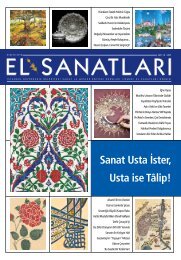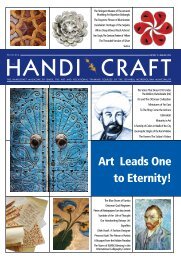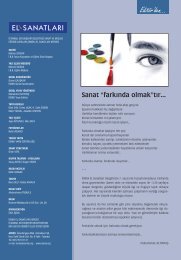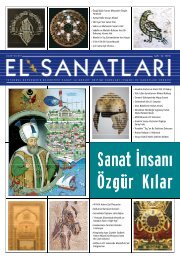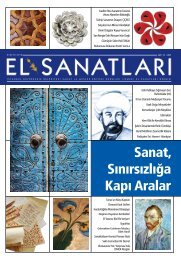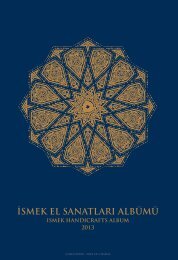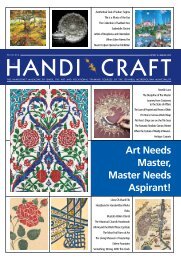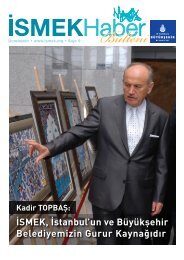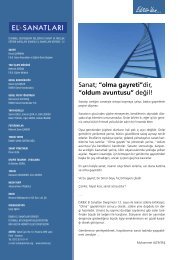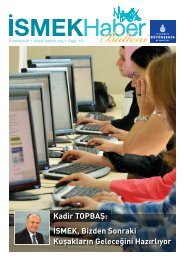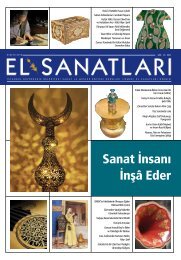Download Link - Ä°SMEK
Download Link - Ä°SMEK
Download Link - Ä°SMEK
You also want an ePaper? Increase the reach of your titles
YUMPU automatically turns print PDFs into web optimized ePapers that Google loves.
Functionality And Esthetics<br />
Combined In Clocks<br />
One of the works worthy of<br />
note in the “Clocks” section,<br />
is the reconstruction of the<br />
clock that is now situated<br />
in the Karaviyyin Mosque<br />
in Morocco. The clock,<br />
which shows the time in<br />
such accuracy enough to<br />
gauge seconds, attracts<br />
attention as well due to<br />
its esthetic image. At first sight, a wooden chamber and a<br />
wooden shape strikes the eye. All the wooden components<br />
of the clock were specially manufactured in Morrocco including<br />
the polishing and paint work. 46 centimeters wide, the<br />
clock face is made up of brass and the ring is made up of<br />
bronze. The clock is 2 meters high and 4 meters wide while<br />
all the bowls within the clock are made up of copper.<br />
Another showcase item which combines scentific novelty<br />
with esthetics is the elephant water clock designed by El-<br />
Cezeri, a scientist from Diyarbakır. The actively working<br />
clock has been reconstructed according to information<br />
gathered from old calligraphy drafts<br />
found in the Topkapı Palace library. The<br />
various items found on El-Cezeri’s elephant<br />
water clock, represent different<br />
civilizations. Another salient piece<br />
in the museum is the “cup clock”<br />
which is also designed by El-Cezeri.<br />
He tells in his book named “El-Cami<br />
beyn el-ilm ve l-amel”, that he designed<br />
this clock as a result of his own invention<br />
upon the will of sultan es-Salih Ebu el-Feth<br />
Mahmud bin Muhammed bin Karaarslan.<br />
Talking about clocks it would be proper to mention<br />
“Ridvan es-saati’s water clock. Engraved from hard<br />
wood and bearing pearl ornaments, this<br />
clock catches the eye right away. In the<br />
info. note, it says that this clock By<br />
es-Saati was designed according<br />
to unequal hours and temporal<br />
hours priciples.<br />
The cup clock, designed by the<br />
famous astronome Ali b. Abdarrahman<br />
b. Ahmed ibn Yunis who<br />
executed his scientific studies in<br />
Egypt and named “Sureyya” is<br />
another item worth seeing in<br />
the museum. In this clock, 1<br />
bulb turns off for each hour<br />
elapsed at night. The first<br />
bulb contains gasoil to<br />
burn for as much as 1<br />
hour, while the 12th<br />
bulb has enough to<br />
burn for 12 hours. If<br />
bulbs are burned at the<br />
same time, their numbers<br />
are read they burn<br />
out. According to Ibni Yunis the twelveth bulb has 36 dirhams<br />
of gasoil for the longest day of the year while for the<br />
shortest day the required amount of gasoline is 24 dirhams.<br />
Thus the bulbs show unequal hours.<br />
The Mechanic "LUNAR AND SOLAR CALENDAR" by El-Biruni (died 1048)<br />
It’s Worth Seeing The Astrology Section<br />
The astrology section is one of the most popular parts of<br />
the The Islam Science and Tecnology Museum. The celestial<br />
globes, observatories, observatory tools, the solsticial ring, astrolabes<br />
ans so forth… While our knowledge store is growing,<br />
we wonder that there is no need for the Islamic world to<br />
feel any inferiority against the West in the face<br />
of these scientific accomplishments by the<br />
muslim scientists.<br />
The model of the astronomical tool built by Cabir b. Eflah (12th century)<br />
named TORQUETUM – also known as the Turkish tool – by the Europeans.<br />
The information plates adjacent to<br />
each artifact grows our knowledge<br />
further. For instance we learn that<br />
the first observatories recognized<br />
by the history of astronom are named<br />
after Caliph Memun. His deep interest<br />
in astronomy and its progress in his own<br />
state motivated him to establish two observatories,;<br />
one in Damascus and the other in Baghdad,<br />
both built on top of hills. Memun aimed to reach<br />
more precise measurements of celestial distances<br />
through more developed instruments and<br />
endless observation. Caliph Memun<br />
therefore is the first person to<br />
found an observatory in the history<br />
of astronomy. At one time,<br />
the 3 greatest observatories in<br />
the world existed in Meraga,<br />
Semerkand and Istanbul; all governed<br />
by muslim states and these<br />
observatories made very delicate<br />
calculations based on their<br />
observations.<br />
51



